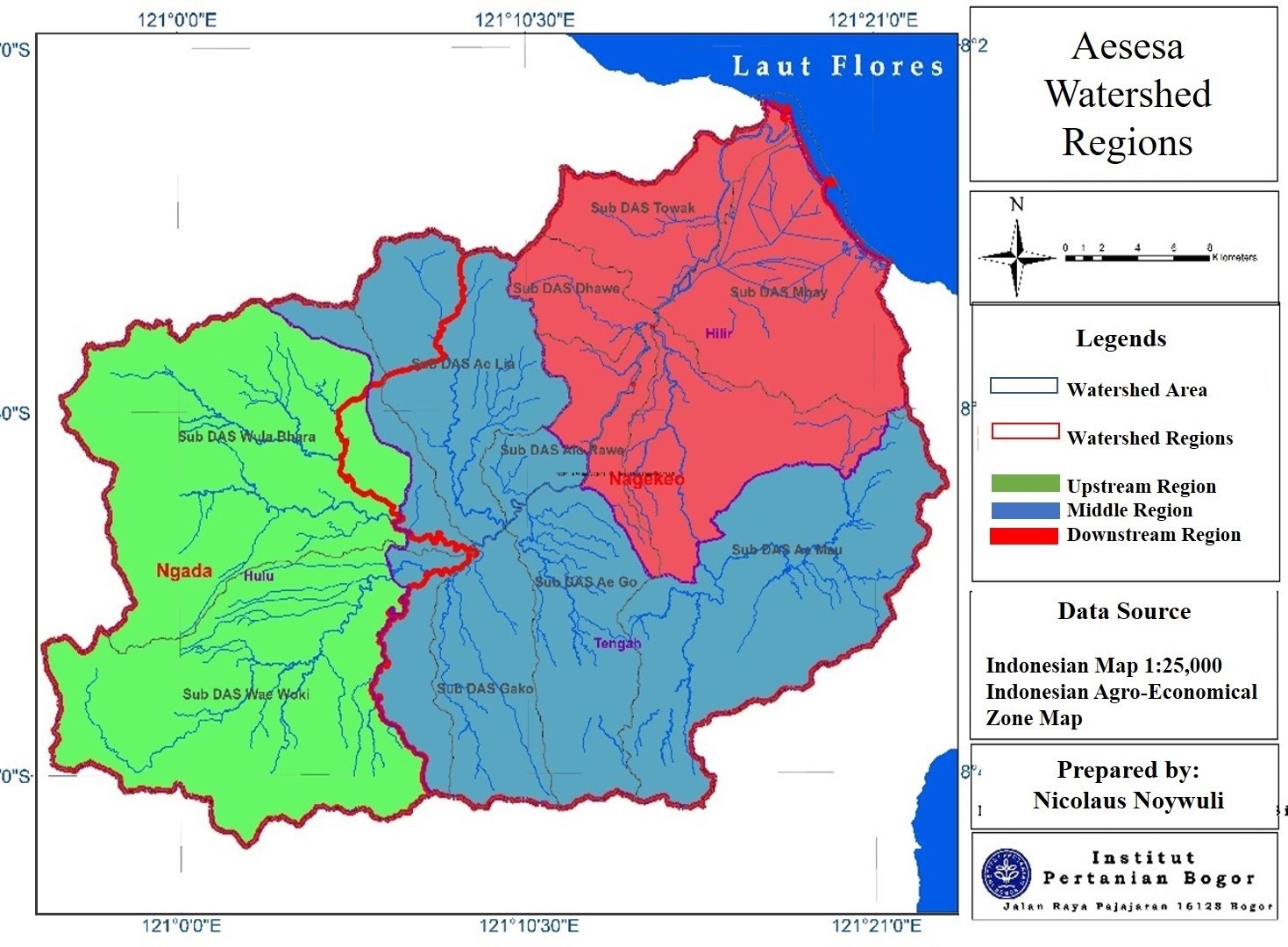Assessment of Watershed Carrying Capacity for the Aesesa Flores Watershed Management, East Nusa Tenggara Province of Indonesia DOI: 10.32526/ennrj.17.3.2019.20
Main Article Content
Abstract
The Aesesa Flores (AF) watershed has an important role for the community in the district of Ngada and Nagekeo, East Nusa Tenggara Province of Indonesia. However, in recent years, over exploitation of natural resources in the AF watershed has caused severe land degradation in the region. This study analyzed the carrying capacity of the AF watershed. The assessment of the AF watershed carrying capacity in this study was done according to the Indonesian Ministry of Forestry Regulation Number P.61/2014 that regulates the monitoring and evaluation of watershed management. The main objectives of this study were to assess the carrying capacity of the AF watershed, and evaluate the suitability of the aforementioned regulation to its condition. The results of carrying capacity analysis showed that the upstream region of the AF watershed was categorized to have a low carrying capacity condition, while both the middle and downstream region of the watershed were categorized to have a moderate carrying capacity condition. These results indicated that there was a need to prioritize the rehabilitation and land management in the upstream region of the AF watershed, in order to improve its condition.
Article Details
Published articles are under the copyright of the Environment and Natural Resources Journal effective when the article is accepted for publication thus granting Environment and Natural Resources Journal all rights for the work so that both parties may be protected from the consequences of unauthorized use. Partially or totally publication of an article elsewhere is possible only after the consent from the editors.
References
2. Arsyad S. Soil and Water Conservation. Bogor, Indonesia: IPB Press; 2010.
3. Asdak C. Hydrology and the Management of Watershed. Yogyakarta, Indonesia: Gadjah Mada University Press; 2010.
4. Brontowiyono W, Lupiyanto R, Malik AH. Improving carrying capacity by developing rainwater harvesting: a case of Oyo watershed, Gunungkidul, Indonesia. Jurnal Sains and Teknologi Lingkungan 2009;1(1):86-98.
5. Genskow KD, Born SM. Organizational dynamics of watershed partnerships: a key to integrated water resources management. Journal of Contemporary Water Research and Education 2006;135(1):56-64.
6. Guo Z, Shao M. Soil water carrying capacity of vegetation and soil desiccation in artificial forestry and grassland in semi-arid regions of the Loess Plateau. Acta Ecologica Sinica 2003;23(8):1460-647.
7. Hui C. Carrying capacity, population equilibrium, and environment's maximal load. Ecological Modelling 2006;192(1-2):317-20.
8. Imperial MT. Using collaboration as a governance strategy: Lessons from six watershed management programs. Administration and Society 2005;37(3): 281-320.
9. Indonesian Government. Watershed Management Regulations: Indonesian Government Regulation Number 37/2012. Jakarta, Indonesia: Indonesian Ministry of Internal affairs; 2012.
10. Indonesian Ministry of Forestry (Kemenhut). Monitoring and Evaluation of Watershed Magement: Indonesian Ministry of Forestry Regulation Number P.61/2014. Jakarta, Indonesia: Indonesian Ministry of Forestry; 2014a. (in Indonesian)
11. Indonesian Ministry of Forestry (Kemenhut). Watershed Classification and Criteria: Indonesian Ministry of Forestry Regulation Number P.60/2014. Jakarta, Indonesia: Indonesian Ministry of Forestry; 2014b. (in Indonesian)
12. Lu Y, Xu H, Wang Y, Yang Y. Evaluation of water environmental carrying capacity of city in Huaihe River Basin based on the AHP method: A case in Huai'an City. Water Resources and Industry 2017;18:71-7.
13. Noywuli N, Sapei A, Pandjaitan NH, Eriyatno. The socio-economic and governance dynamics of the Aesesa watershed management in the East Nusa Tenggara Province of Indonesia. Proceeding of the 1st Indonesian National Conference on the Watershed Management; 2017 Nov 27-28; The University of Riau, Riau: Indonesia; 2017.
14. Noywuli N, Sapei A, Pandjaitan NH, Eriyatno. Sustainability assessment in watershed management in the Aesesa Flores Watershed, East Nusa Tenggara Province of Indonesia. Journal of Sustainability Science and Management 2018;13(2):129-42.
15. Paimin, Pramono IB, Purwanto, Idrawati DR. Planning System of the Watershed Management. Centre of Conservation and Rehabilitation. Jakarta, Indonesia: Indonesian Ministry of Forestry; 2012.
16. Rahadi B, Nurlaeih NN, Lusiana N. Environmental Carrying Capacity Assessment in City of Batu, Indonesia. Malang, Indonesia: Faculty of Agriculture Brawijaya University; 2014.
17. Reddy VR, Saharawat YS, George B. Watershed management in South Asia: A synoptic review. Journal of Hydrology 2017;551:4-13.
18. Ren C, Guo P, Li M, Li R. An innovative method for water resources carrying capacity research-metabolic theory of regional water resources. Journal of Environmental Management 2016;167:139-46.
19. Shabbir R, Ahmad SS. Water resource vulnerability assessment in Rawalpindi and Islamabad, Pakistan using analytic hierarchy process (AHP). Journal of King Saud University-Science 2016;28(4):293-9.
20. Suryanto. Carrying Capacity of a Watershed for the Development of Settlement. Semarang, Indonesia: Diponegoro University Press; 2007.
21. Watershed Management Agency of Benain Noelmina (BPDAS Benain Noelmina). Final Report on the Aesesa Flores Watershed Characteristic. East Nusa Tenggara, Indonesia: Indonesian Watershed Management Agency; 2012. (in Indonesian)
22. Watershed Management Agency of Benain Noelmina (BPDAS Benain Noelmina). Strategic Management Planning on the Sustainable Watershed Management Planning of Aesesa Flores Watershed. East Nusa Tenggara, Indonesia: Indonesian Watershed Management Agency; 2013. (in Indonesian)
23. Yang J, Lei K, Khu S, Meng W. Assessment of water resources carrying capacity for sustainable development based on a system dynamics model: A case study of Tieling City, China. Water Resources Management 2015;29(3):885-99.
24. Ye W, Xu X, Wang H, Wang H, Yang H, Yang Z. Quantitative assessment of resources and environmental carrying capacity in the northwest temperate continental climate ecotope of China. Environmental Earth Sciences 2016;75(10):868.
25. Zhou XY, Lei K, Meng W, Khu ST, Zhao J, Wang M, Yang J. Space-time approach to water environment carrying capacity calculation. Journal of Cleaner Production 2017;149:302-12.

